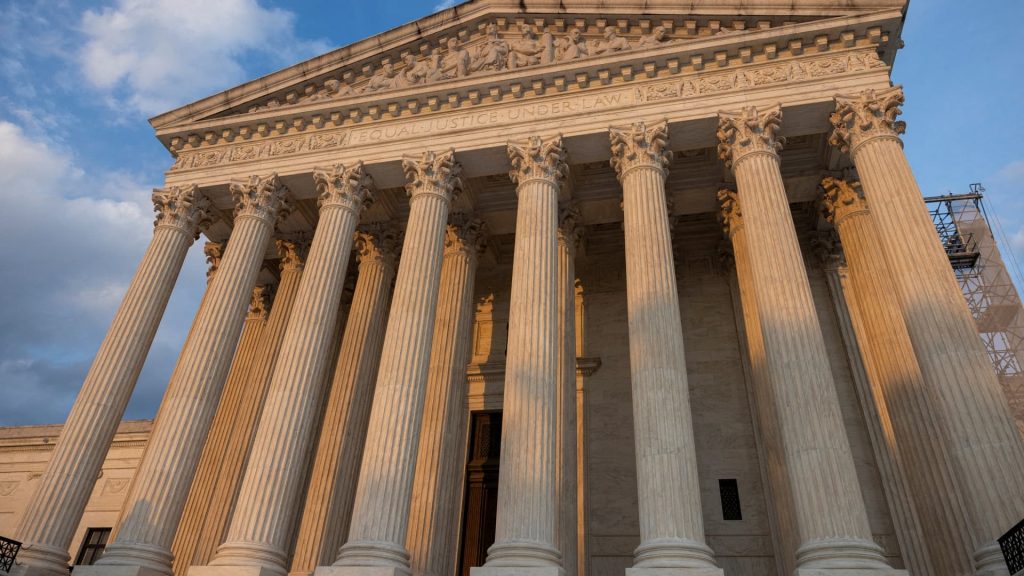The U.S. Supreme Court building in Washington, July 19, 2024.
Kevin Mohatt | Reuters
The Supreme Court on Thursday strongly suggested that Federal Reserve board members would have special protection against being fired by a president in a ruling that, for now, allows President Donald Trump to fire two members of other federal agencies’ boards.
The Supreme Court in its ruling said, “We disagree” with arguments by Gwynne Wilcox of the National Labor Relations Board and Cathy Harris from Merit Systems Protection Board that their challenges to their terminations “necessarily implicate the constitutionality of for-cause removal protections for members of the Federal Reserve’s Board of Governors or other members of the Federal Open Market Committee.”
“The Federal Reserve is a uniquely structured, quasi-private entity that follows in the distinct historical tradition of the First and Second Banks of the United States,” the majority ruling said.
The three liberal members of the court dissented from the decision by six conservative justices, which keeps Wilcox and Harris off their boards as their lawsuit challenging their terminations is pending.
While Thursday’s decision does not explicitly bar Trump — or any other president — from firing a Federal Reserve board member, it suggests that any effort by a president to do so would face strong resistance from the Supreme Court as currently constituted.
A federal district court judge in Washington, D.C., had enjoined Trump from removing both women from their respective boards. An appeals court later upheld that order.
But in early April, the Supreme Court stayed those rulings while the case continued, meaning that Trump did not have to reinstate the women to their boards.
That temporary order was formalized in Thursday’s opinion by the high court.
“Because the Constitution vests the executive power in the President … he may remove without cause executive officers who exercise that power on his behalf, subject to narrow exceptions recognized by our precedents,” the majority said in the opinion.
“The stay reflects our judgment that the Government is likely to show that both the NLRB and MSPB exercise considerable executive power,” the opinion said. “But we do not ultimately decide in this posture whether the NLRB or MSPB falls within such a recognized exception; that question is better left for resolution after full briefing and argument.”
The majority also said their stay “reflects our judgment that the Government faces greater risk of harm from an order allowing a removed officer to continue exercising the executive power than a wrongfully removed officer faces from being unable to perform her statutory duty.”
Federal Reserve Chairman Jerome Powell, who has been a target of criticism from Trump, in November said that he would not resign if Trump asked him to do so.
Powell also said that the president does not have the power to fire him.
“Not permitted under the law,” Powell said.
In a written dissent Thursday, Justice Elena Kagan said that under existing law, Trump “has no legal right to relief” from the order that Wilcox and Harris be reinstated while their lawsuit proceeds.
“Congress, by statute, has protected members of the NLRB and MSPB (like Wilcox and Harris) from Presidential removal except for good cause,” wrote Kagan, whose dissent was joined by the two other liberal justices, Sonia Sotomayor and Ketanji Brown Jackson.
The dissent notes that “for 90 years,” the Supreme Court’s ruling in a case known as Humphrey’s Executor v. United States has stood as precedent, giving bipartisan administrative federal bodies “a measure of independces from presidential control.”
Kagan called out the majority for its exemption for the Federal Reserve.
“The majority closes today’s order by stating, out of the blue, that it has no bearing on ‘the constitutionality of for-cause removal protections’ for members of the Federal Reserve Board or Open Market Committee,” Kagan wrote.
“I am glad to hear it, and do not doubt the majority’s intention to avoid imperiling the Fed,” she wrote. “But then, today’s order poses a puzzle. For the Federal Reserve’s independence rests on the same constitutional and analytic foundations as that of the NLRB, MSPB, FTC, FCC, and so on — which is to say it rests largely on Humphrey’s.”
“So the majority has to offer a different story: The Federal Reserve, it submits, is a “uniquely structured” entity with a ‘distinct historical tradition’ —and it cites for that proposition footnote 8 of this Court’s opinion in Seila Law,” Kagan wrote.
But — sorry—footnote 8 provides no support,” she added. “Its only relevant sentence rejects an argument made in the dissenting opinion ‘even assuming [that] financial institutions like the
Second Bank and Federal Reserve can claim a special historical status.’ “
“And so an assumption made to humor a dissent gets turned into some kind of holding,” Kagan wrote. “Because one way of making new law on the emergency docket (the deprecation of Humphrey’s) turns out to require yet another (the creation of a bespoke Federal Reserve exception). If the idea is to reassure the markets, a simpler—and more judicial—approach would have been to deny the President’s application for a stay on the continued authority of Humphreys.”


